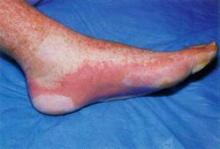Elevated plasma levels of the biomarker ST2, measured 2 weeks after allogeneic hematopoietic stem-cell transplantation, predicted which patients who develop graft-vs.-host disease are unlikely to respond to treatment and are thus at high risk of death within 6 months, according to a report published online Aug. 8 in the New England Journal of Medicine.
Approximately half of allogeneic stem-cell transplant recipients develop acute GVHD, and those who don’t respond to high-dose systemic glucocorticoids within 1 month are at high risk of dying within 6 months without relapse of the primary disease for which the transplant was performed. At present, it is difficult to predict which patients will not respond to glucocorticoids.
Adding a patient’s ST2 (suppression of tumorigenicity 2) level to the clinical grade and the target-organ stage of GVHD significantly improves risk prediction, particularly in the important subgroup of patients who have lower-GI GVHD, said Dr. Mark T. Vander Lugt of the department of pediatrics, University of Michigan, Ann Arbor, and his associates.
"The improved risk stratification of patients with GVHD with the use of ST2 may permit early evaluation of additional therapies, before the development of resistant disease," they wrote (N. Engl. J. Med. 2013 Aug. 8;369:529-39 [doi:10.1056/NEJMoa1213299]).
This early identification may also "permit more stringent monitoring and preemptive interventions."
ST2, a recently discovered member of the interleukin-1 receptor family, is expressed on hematopoietic cells that play a role in diseases mediated by type-2 helper T cells and is also secreted by endothelial cells, epithelial cells, and fibroblasts in response to inflammatory stimuli.
Dr. Vander Lugt and his colleagues assessed numerous candidate plasma biomarkers to determine which, if any, showed the strongest association with nonresponse to GVHD therapy and could thus be used as risk predictors.
They began by testing plasma samples collected 16 days after transplantation from 10 patients who went on to have a complete response to GVHD therapy and 10 who went on to have progressive GVHD. They identified and quantified 571 proteins in these samples, and found that 197 of them were overexpressed by a factor of at least 1.5 in the patients with progressive GVHD. Twelve of these proteins, in addition to ST2, could be measured using commercially available antibodies suitable for ELISA.
ST2 was the single most accurate biomarker at discriminating between plasma samples from patients who responded to GVHD therapy and plasma samples from patients who did not. The six other best biomarkers were then assessed as a panel and compared against ST2 in samples taken from 381 patients at the onset of GVHD.
The ST2 level was found to be superior to the six-biomarker panel in predicting which patients with GVHD would not respond to glucocorticoids within a month of initiating the treatment, which is an accepted surrogate 6-month mortality. It also was the best predictive biomarker when tested further in three independent cohorts totaling 673 patients, the investigators said.
Patients with high ST2 levels were 2.3 times more likely than those with low ST2 levels to develop treatment-resistant GVHD, and 3.7 times as likely to die within 6 months.
Moreover, "when measured as early as day 14 after transplantation, ST2 concentration was a better predictor of the risk of death than were the other known risk factors, including the age of the recipient, conditioning intensity, donor source, and HLA [human leukocyte antigens] match," Dr. Vander Lugt and his associates wrote.
"We believe that our results may affect the assessment of GVHD risk before the development of GVHD and at the onset of the clinical signs of GVHD; however, a generalizable definition of high risk has yet to be developed and will require larger studies," they added.
The study was supported by grants from the National Institutes of Health. The University of Michigan has licensed a pending patent application for the biomarker test to ViraCor and any revenue will be shared with the inventors at the University of Michigan and the Fred Hutchinson Cancer Research Center, Seattle.



